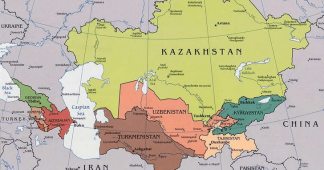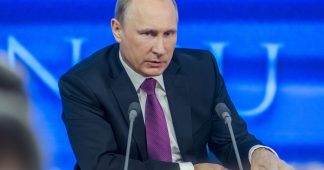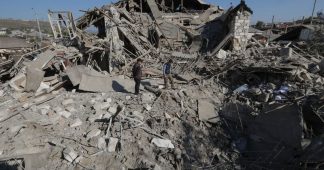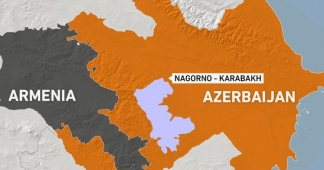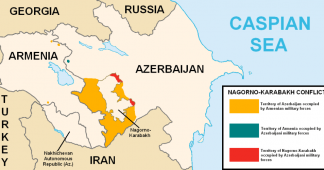Azerbaijani President Ilham Aliyev is taking advantage of the domestic instability in Yerevan and once again using a threatening tone against Armenia. On the 6th of February, Azerbaijani media reported that President Aliyev accused Armenia of “obstructing the creation of the Zankezur corridor.” This is a dangerous development because the trilateral statement of November 9, 2020 never mentions the term “corridor” in any Armenian territory connecting Azerbaijan proper to Nakhichevan. “We [Azerbaijan] are ready to collaborate with Armenia. How many times have the deputy prime ministers [of the two countries] met already? Armenia refuses to collaborate,” said Aliyev during a meeting with the ruling “New Azerbaijan” Party. “Now Armenia wants to obstruct the implementation of the Zankezur corridor. But they will not succeed; we will force them,” he asserted. Aliyev also stated that the opening of the “Zankezur corridor” is a historic achievement and great political victory for Baku, once again mentioning that Zankezur is “historic Azerbaijani territory.” What’s remarkable is that this time Aliyev directly threatened Armenia, and the regional developments may work to his advantage again.
Aliyev’s remarks can be looked at from the context of certain dissatisfaction within Azerbaijani society regarding the latest developments in Artsakh. In February, authorities in Artsakh introduced a bill to add Russian as an official language alongside Armenian. In an explanatory note on the reasons for introducing the draft bill, its authors cited “cultural, military and economic relations” between Nagorno-Karabakh and Russia, historical memory and the fact that many residents already speak Russian as their second language. “The long-term presence of Russian peacekeepers in Artsakh; the awareness of the need to jointly solve numerous social and communication problems; and cooperation in the areas of construction, healthcare, education, and science require a reassessment of the role of the Russian language,” RIA Novosti quoted from the document submitted to the National Assembly. Furthermore, the deployment of Artsakh troops alongside the Russian peacekeeping forces in the Russian-controlled zone of Artsakh raised alarms in Azerbaijan. Azerbaijan repeatedly demanded the disarming of “Armenian militias” in Artsakh. All these developments pushed Aliyev to take a harsh position.
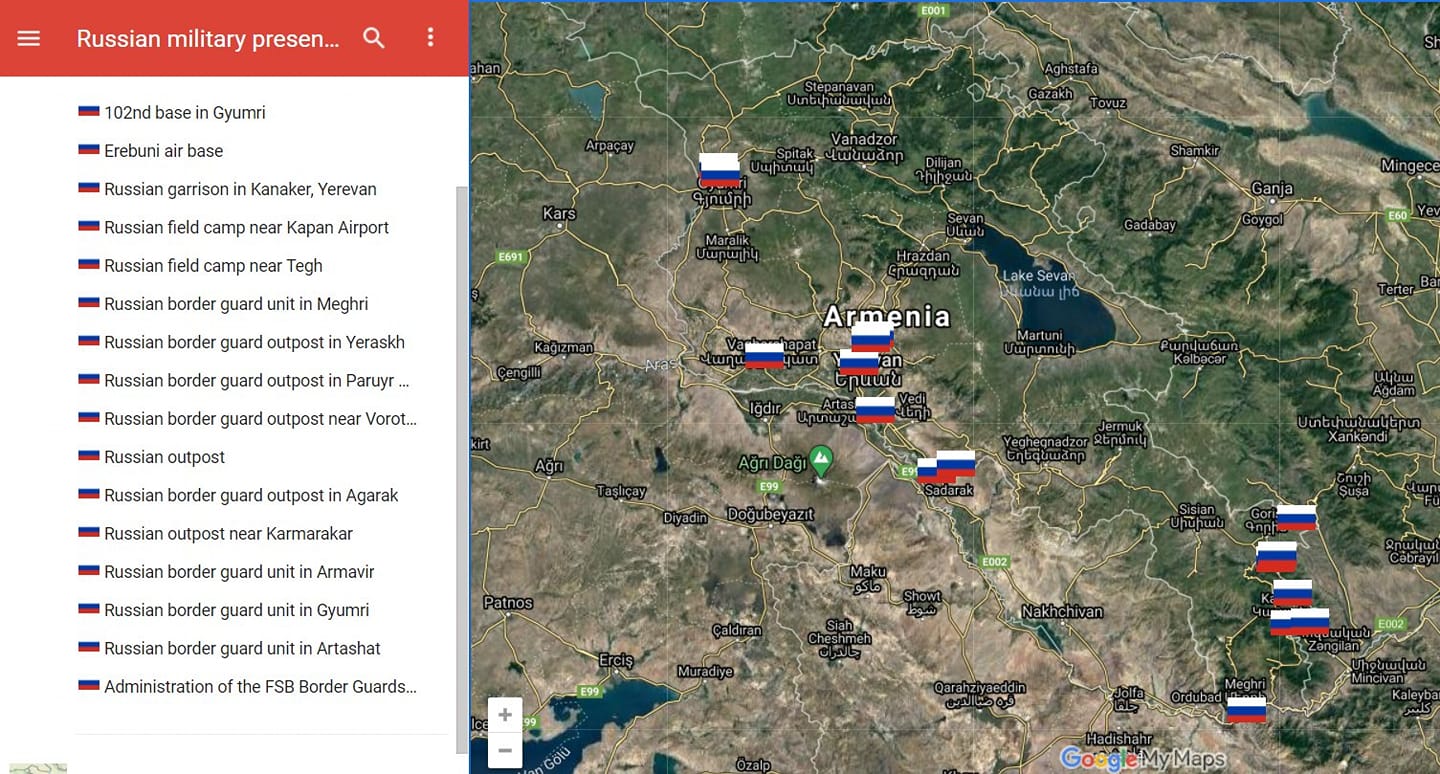
In response to these developments, on February 26 Aliyev made important statements that hint towards the region heading for a new round of escalation. The Azerbaijani President rejected the notion that Russian peacekeepers will stay for more than five years and made clear his intentions of going to war if necessary. “As for the peacekeepers, their activities in the territory of Azerbaijan are temporary and transitory. These soldiers are on a special mission. This does not mean a military base. Russian peacekeepers are carrying out a peacekeeping mission here,” he said. When it comes to granting “special status” for Nagorno-Karabakh in Azerbaijan he said, “Nagorno-Karabakh does not exist. Everyone recognizes it as an integral part of Azerbaijan. The only official language in Azerbaijan is Azerbaijani. Therefore, there can be no official status of another language in the territory of Azerbaijan.” This was a clear message that he wants to eliminate Armenians from Artsakh. He also stressed that he is not planning to give anyone cultural or linguistic rights, rejecting Russian (in addition to already-existing Armenian) an official language in Artsakh. Additionally, he insisted that no one should use the term “Nagorno Karabakh,” but only Karabakh, repeating his racist and non-factual rhetoric that Armenians “moved to the region in the 19th century.”
Anush Ghavalyan, a political analyst from Artsakh, told the Armenian Weekly that Artsakh doesn’t have any commitments to Baku. “The Republic of Artsakh doesn’t have any kind of a vertical relationship with Azerbaijan,” she explained. “Azerbaijan’s president may speak whatever he wants to meet the expectations of his people, but the reality on the ground is quite different. Artsakh fully exercises its jurisdiction over the territories that remain under its control after the 44-day war and the November 9 trilateral statement between Armenia, Azerbaijan and Russia,” Ghavalyan said. She added that the continuing development of Artsakh’s relationship with Russia takes into consideration the presence of Russian peacekeeping forces on the ground. When asked if Aliyev wishes to see the Russian peacekeepers leave Artsakh soon, Ghavalyan argued that Aliyev shows his true intention to expel the Armenians of Artsakh from their homeland. However, Russia is in the region not only to ensure the security of the Artsakh people, but also to defend its national interests in the South Caucasus. Hence, Aliyev is delusional to think the Russians would leave the territories of Artsakh easily.
Aliyev continued with his antagonistic tone on March 4 during an online summit of the Economic Cooperation Organization (ECO). The Azerbaijani President invited the leaders of the member countries to use the “Zankezur Corridor,” a statement that provoked Armenia. It is worth noting that the ECO was formed in 1985 by Turkey, Iran and Pakistan; in 1992, Kazakhstan, Azerbaijan, Afghanistan, Kyrgyzstan, Tajikistan, Turkmenistan and Uzbekistan joined. Aliyev said that “if Armenia behaves normally, [it] will also be able to benefit from this process,” once again using the term “corridor” and saying that “Zankezur is a historical territory of Azerbaijan,” which leads to questions about the true intentions of Azerbaijan and Turkey over the region.
Other high-ranking Azerbaijani officials, as well as Azerbaijani media, have also started using the term “Zankezur corridor.” Azerbaijani MP Fazil Mustafa in his interview with turkustan.info broached the subject and linked the unblocking of roads via Armenia to Nakhichevan to the status of the Lachin corridor. The Azerbaijani MP said that the road through Zankezur must be opened “immediately,” even though the November 9 trilateral statement gives Armenia a timeline of three years to renovate the road. Mustafa stated that if this road does not open, Azerbaijan must respond by declaring that it will close the Russian-controlled Lachin corridor. This would be a clear violation of the November 9 trilateral statement.
Meanwhile, Armenia’s Foreign Ministry spokesperson Anna Naghdalyan stressed once again that Article 9 of the November 9 trilateral statement does not mention the establishment of a corridor. Naghdalyan said that by calling Zankezur “Azerbaijani historical land” and making reference to an imaginary corridor, Azerbaijan’s president is deliberately undermining the implementation of the November 9 and January 11 trilateral statements. The January 11 trilateral statements signed in Moscow mentioned the unblocking of economic and trade routes and railways between Armenia and Azerbaijan.

Meanwhile, both on the local and regional level, there are indicators that military operations escalate in the region. On a local level, there are many ways Azerbaijan can escalate the situation in Syunik and pressure the Armenian government for further compromise. First, Baku may try to encourage skirmishes between Azeri and Armenian troops and later demand the establishment of a demilitarized zone on the border with or within Syunik under the pretext of “security and stability.” Second, Baku can demand a status for the highways or railroads passing from Meghri connecting Azerbaijan proper to Nakhichevan. This is only possible through an armed clash where the Armenian side is defeated and by adding a clause or amending the trilateral statement of November 9. Third, Azerbaijani troops can conduct sabotage activities or send mercenaries to conduct terrorist activities and accuse Armenia, thus demanding shared sovereignty or a certain legal status for the international routes guarded by Russia within the territorial borders of Armenia. All these scenarios would be disastrous to Armenia as it would lose its shared border with Iran and become a client state of Russia. Of course, these scenarios are not possible without the passive position of Iran and Russia.
To prevent such a clash, between February 26 and March 10, several Russian military transport aircraft of the Russian Aerospace Forces landed in Erebuni military airport from Russia and Syria. There was a similar activity from the Turkish side towards Nakhichevan. In another suggestion that Azerbaijan may be preparing for a new military operation, a Turkish Boeing 737 AEW&C early warning and control aircraft was circling near the border with Armenia. This is the same plane code-named “CENAH01” which was used during the early days of the recent war. There have also been reports that Azerbaijan is calling up reservists. Meanwhile, Aliyev repeatedly warned Armenia not to revise the agreement otherwise it would end up with a similar fate as in November 2020. He also expressed concerns about Russia’s role in modernizing and providing new weapons for the Armenian army. In response, Armenian Defense Minister Vagharshak Harutyunyan told RIA Novosti that military reforms are underway, and he highlighted Russia’s direct involvement in this process. According to him, the main efforts will be directed to the development of control systems, intelligence, electronic warfare, air defense and unmanned aircraft, missile forces and artillery.
These developments must not surprise us, as beginning on February 1 Turkey and Azerbaijan conducted joint military drills in Kars. Recently, the Azerbaijani defense ministry declared that on March 15 the army will hold an operational-tactical exercise to be prepared to wage war in “mountainous areas.” The exercise will involve up to 10,000 military personnel, up to 100 tanks and other armored vehicles, up to 200 missiles and artillery systems of various caliber, multiple launch rocket systems and mortars, up to 30 military aviation assets, as well as unmanned aerial vehicles for various purposes. Armenia will also be conducting military exercises on March 16. In an interview with “Turkey Today” on Radio Voice of Van in Beirut, an expert on Turkish studies Varuzhan Geghamyan said that Turkey has legitimized its presence in the South Caucasus after the war. Ankara will use every means to exert its influence on the roads and pipelines passing via the Syunik region.
However, my greatest fear is on a regional level. It is no secret that Ukraine is preparing for war or at least triggering an armed conflict in Russian-controlled Donbass with Turkish and Western blessing. It has been two weeks since I began monitoring the Ukrainian and Russian army’s supply routes and deployment of heavy weapons near Donbass. Kyiv, motivated by the Turkish and Azerbaijani victory in Artsakh, tried to establish military relations with Turkey and bought Turkish Bayraktar TB2 drones. Russia, aware that it may engage in a two-front war and knowing well that Armenia cannot defend itself against another Turkish-Azerbaijani invasion, is consolidating its presence in southern Armenia by building military posts and reopening the abandoned airfield of Sisian in Syunik.
Most concerning is that Turkey and Azerbaijan may take advantage of a possible war in Ukraine to divert Russian attention from the South Caucasus and conduct an operation against Armenia. According to Greek City Times, the question begs whether Moscow would be able to handle simultaneous conflicts in the South Caucasus and Ukraine, if Azerbaijan and Ukraine are to launch simultaneous offensives in the spring. To add fuel to the fire, Turkey may open new fronts in Syria and Libya thus putting Russia in a difficult position. Turkey would likely be urging Azerbaijan and Ukraine to make simultaneous actions to gain concessions from Russia, such as forcing Armenia to open a transportation corridor between Azerbaijan-proper and Nakhichevan and giving a certain status to the Tatars of Crimea. The fear is that Russia may choose the first, as Crimea falls within the current territories of the Russian Federation and any Turkish intervention in Russia’s domestic affairs would be disastrous for the Kremlin.
Meanwhile, since it seems authorities in Yerevan are “busy with domestic developments” preaching “peace and coexistence” towards the enemies and liquidating top army generals, it will be impossible for Armenia to defend itself against a Turkish-Azerbaijani joint attack. Azerbaijan may take advantage of the political uncertainty in Yerevan, Armenia’s isolation in the international arena and Russia’s attention in Ukraine, and launch an operation on Syunik. There are those who disregarded warnings that if Armenians lost Artsakh to Azerbaijan, Syunik would be threatened too. The loss of Syunik and the border with Iran would endanger Armenia’s very existence. A report that was published in June 2012 by “Stratfor” (an intelligence-based research center with close ties to the CIA) used the term “Zankezur corridor” and explained the strategic importance of the region, commenting that “whoever controls the Zangezur Corridor can project power into the Turkish sphere of influence in Anatolia, the Russian sphere of influence in the intra-Caucasus and directly into the Persian core territories.” The report predicted that in the future, tensions would arise between Turkey, Russia and Iran over this region, and the demographic decline of the Armenian population in the area may cause certain problems for the Armenian authorities. A century ago Karekin Njteh’s heroic resistance against the combined Turkish, Azeri and Bolshevik forces in Zankezur enabled the existence of modern-day independent Armenia – something that would have been impossible without the backbone of the country, the region of Syunik. Today, Syunik once again is under threat, and it is up to Armenians to decide the destiny of their nation.
* Yeghia Tashjian is a regional analyst and researcher. He has graduated from the American University of Beirut in Public Policy and International Affairs. He pursued his BA at Haigazian University in Political Science in 2013. He founded the New Eastern Politics forum/blog in 2010. He was a Research Assistant at the Armenian Diaspora Research Center at Haigazian University. Currently, he is the Regional Officer of Women in War, a gender-based think tank. He has participated in international conferences in Frankfurt, Vienna, Uppsala, New Delhi, and Yerevan, and presented various topics from minority rights to regional security issues. His thesis topic was on China’s geopolitical and energy security interests in Iran and the Persian Gulf. He is a contributor to the various local and regional newspapers and presenter of the “Turkey Today” program in Radio Voice of Van.
Published at armenianweekly.com
